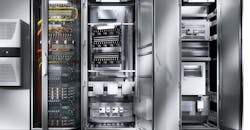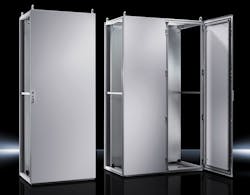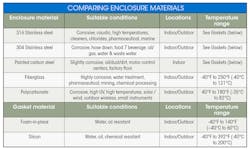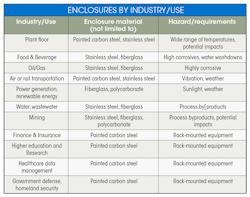Selecting the Right Materials for Industrial Enclosures
Industrial enclosures are made from a wide range of materials including painted carbon steel, stainless steel 304, stainless steel 316, fiberglass reinforced polyester (more popularly known simply as “fiberglass”), and polycarbonate.
Accessories and hardware are also made from a diverse list of materials: cast or sheet aluminum, clear zinc-plated steel, nickel-alloy plated steel, opaque molded plastic, transparent acrylics (such as Plexiglas and Lucite), polycarbonates (Lexan and Makrolon), and safety glass.
So, what should your next enclosures be made of? That depends on a host of factors. But knowledge of the available materials is also helpful.
Enclosure Materials
Painted carbon steel is the most cost-effective metallic choice and is mainly used for indoor enclosures. The paint finish consists of an inner layer of primer and an outer layer of powder coat which creates a durable, scratch-resistant surface. In the case of accidental scratches, touchup paint can cover exposed bare metal. The metal, even painted, has limited resistance to solvents, alkalis, and acids.
The TS 8 Carbon Free Standing Enclosure from Rittal is made mostly of painted carbon steel, the most cost-effective metal for enclosures.
Type 304 stainless steel is an iron-based alloy containing between 18% and 20% chromium. It resists oxidation (rust) and provides protection from corrosive solvents, alkalis, and some acids. Stainless steel is ideal for applications exposed to wash down cleaning processes. It is used for indoor and outdoor enclosures.
Type 316 stainless steel contains molybdenum, which gives it better corrosion resistance than Type 304 has. It also has better resistance against sulfates, bromides, chlorine, seawater, high temperatures, and some special acids. Resistance to seawater makes 316 stainless steel well-suited for marine environments. Since Type 316 has good resistance to chemical attack, it is often specified in pharmaceutical manufacturing applications in which excessive metallic contamination must be avoided. Type 316 stainless steel enclosures are used in indoors and outdoors.
Fiberglass reinforced polyester (“fiberglass,” for short) resists corrosion and impacts. It is lightweight, extremely strong, and consists of plastic reinforced by fine glass fibers. Fiberglass enclosures are well suited for corrosive, high-temperature environments. Some fiberglass enclosures are immersion-proof, which means they can be temporarily submerged in water and still fully protect the enclosure’s contents. On the downside, fiberglass colors can fade over time and long-term exposure to sunlight can cause fiber bloom; which is mostly an aesthetic concern, though it can reduce the materials non-conductivity.
Polycarbonates are very durable plastics formed from thermoplastic polymers. Polycarbonate has greater impact resistance than fiberglass and suffers no UV light deterioration. Polycarbonates are much easier to machine than fiberglass, producing cleaner holes and cutouts. Polycarbonate enclosures last longer and better resist weather than fiberglass enclosures. They can also be specified with clear doors, making it possible to monitor installed components while the enclosure door remains closed. Polycarbonate enclosures are typically small, so they are good for housing instruments and as junction boxes for sensitive equipment. Other applications include temperature control monitoring, geophysical sensing, relay modules, keypads, and volume and lighting controls.
Countering Threats
Enclosures can be exposed to several risks inherent in their work sites. Two of the major ones include corrosion and electromagnetic interference (EMI).
Most working sites will be at least mildly damaging since air (oxygen) and water can be slightly corrosive, and both are present at most sites. To identify other corrosion risks to the enclosure, answer the following questions:
- What corrosive gas, vapor, liquid, or dust particles may be present?
- Are multiple corrosive elements present?
- Are these elements ever unstable?
- Will the enclosure be exposed to any byproducts of manufacturing processes?
- Will it be exposed to the weather?
- What temperatures will the enclosure be exposed to?
Some enclosure materials resist corrosion better than others. The material should have protection leveled that match the installation site’s corrosive atmosphere.
Along with the enclosure material, it is important to consider the corrosion resistance properties of the other hardware such as hinges, latches, and locks. They can oftentimes be the weakest link in the enclosure. It is imperative to specify the correct windows, door latches, gaskets, cooling devices, locking accessories, and other options to ensure the entire assembly meets the corrosion resistance requirements.
EMI is an electromagnetic disturbance that affects electrical circuits due to either electromagnetic induction or radiation emitted from an external source. To get the right EMI-resistant properties for the enclosure, ask appropriate questions, such as:
- Will EMI affect the performance of installed components?
- Will the enclosure be exposed to radio or EMI waves?
Metallic enclosures offer a natural barrier to radio and electromagnetic interference. EMI protection from metallic enclosures can be improved by using special gaskets. Non-metallic enclosures offer no EMI protection but can be upgraded with metallic coatings usually applied on the enclosure’s exterior.
Size and Strength
Designers should choose materials for enclosures largely based on what will be inside them and how strong they need to be. One way to determine this is to ask (and answer) the following questions:
- What is the total weight of the equipment being housed?
- Does the enclosure need to be tamper-resistant?
- Is the enclosure location secured or accessible by many?
- Will both operators and maintenance personnel have access?
In many industrial environments, enclosures must withstand abuse and continue to maintain a specific level of environmental protection. Metallic enclosures are stronger and can carry greater loads than non-metallic enclosures, but they are susceptible to dents due to impacts. Non-metallic enclosures resist some impacts but cannot support as much weight as metal enclosures.
The enclosure’s weight may be important to consider when selecting materials. Pole-, wall-, and ceiling-mounted enclosures may need to be manually put into position. Fiberglass or polycarbonate enclosures may be better suited for these installations as they are lighter than metallic enclosures. For outdoor enclosures, a heavier carbon or stainless steel will protect against weather and vandals.
Due to material hardness, adding cutouts and holes to stainless steel enclosures is far more difficult than modifying carbon steel. Modifying painted carbon steel does require paint touchup to protect from corrosion in areas where paint was chipped. Fiberglass and polycarbonate are much easier than steel to modify but they can splinter and produce very fine, potentially harmful dust. Modifications to polycarbonate, however, are more precise and cleanup is easier and safer.
It is important to note that metallic enclosures conduct and dissipate heat. Carbon or stainless steel is the best material choice if the designer is looking for thermal transfer. Metals will let heat dissipate from inside the enclosure to the outside when the outside temperatures are lower than the desired internal temperature. Heat will always flow to colder regions as long as no insulation stands in the way.
Fan-forced air can remove some heat removal process. If outside temperatures are higher than the desired internal temperature, then air conditioning (or air-to-water heat exchangers) may be needed to remove heat from inside metal enclosures.
Fiberglass and polycarbonate enclosures do not conduct heat quickly; they insulate. Therefore, any heat transfer may require fans or air conditioning. The materials in non-metallic enclosures essentially act as insulators, keeping internal temperature warm when outside temperatures are cool and vice-versa.
Metallic enclosures conduct electricity as well as heat, so electrical grounding is required to ensure operators are safe when installing or maintaining internal equipment. Non-metallic enclosures do not conduct electricity, so installed equipment is isolated from the enclosure, providing a safety barrier for operators. With both metallic and non-metallic enclosures, external grounding of installed equipment is required to ensure a clear path to earth ground.
Cost Considerations
The overall price of for an enclosure depends mainly on the cost of the base material. But regardless of cost considerations, appropriate materials should be based on the application and location. Any cost savings realized at the beginning of a project by cutting corners or ignoring risks will be insignificant compared to long-term costs needed to correct problems caused by choosing the wrong enclosure. The correct enclosures must be chosen based on environmental conditions, required strength, modification capabilities, and weight considerations.
Strictly based on enclosure cost, 316 stainless steel would be the most expensive, followed by 304 stainless steel. Fiberglass and polycarbonate materials would be the next, followed by painted carbon steel (the least expensive).
Pricing may vary based on how many enclosures are purchased. Pricing may also be affected by the manufacturer’s sales volume and the availability of raw materials in their supply chain.
Windows for Cabinets
Technological advances in material science have expanded engineers’ options when selecting window materials that meet design needs and budget constraints. Knowing the various materials is critical for making a good choice.
Acrylic (or Plexiglas) is the most cost-efficient window material. It is flexible, lightweight, and has better impact resistance than glass. Thanks to its softness, scratches and blemishes can be removed by buffing. Acrylic has optical clarity, filters UV light, and cracks instead of shattering. Acrylic does not yellow with age and is a better insulator than glass. It also resists weather.
Polycarbonate (or Lexan) is more expensive than acrylic, but is becoming more popular as a window material due to its many advantages over acrylic. It is more impact- and chip-resistant, more flexible, and has greater heat stability than acrylic. Polycarbonate does turn yellow over time and is more likely to scratch than acrylic. Advances in coatings for polycarbonate have improved its UV filtering, light transmission, weathering, and scratch resistance. Some polycarbonates accept screws and tapped holes. It’s also possible to seal polycarbonate windows so they are watertight.
Glass had traditionally been the material of choice for windows, but due to the advances in polycarbonates, glass is now becoming less popular. The disadvantages of higher cost, greater weight, inflexibility, and poor insulating properties often outweigh glass’ advantages of visual clarity, heat resistance, and ease of cleaning.
Whatever the application or environment, choosing the right enclosure material ensures components and equipment housed inside will be protected from the environment, electronic interference, and physical abuse for years to come. Choosing the appropriate material will also make the final product aesthetically appealing, while protecting the equipment inside and operators servicing that equipment.
Steve Sullivan is the training and development supervisor at Rittal. If you have any questions regarding enclosures, contact Rittal at (800) 477-4000.
About the Author
Steve Sullivan
Training & Development Supervisor
Steve Sullivan is the Training Supervisor at Rittal North America LLC where he oversees instructor-led, computer- and web-based learning and development. In over 20 years with Rittal, Steve also worked in production control, managed tradeshows and exhibits, and conducted sales training for both industrial and IT products in the Americas and abroad. Steve co-founded Rittal University Online and is the North American point-of-contact for Rittal’s Global Trainer Network. Steve has a B.S. in Psychology from Wright State University, and an MBA from the University of Phoenix.




